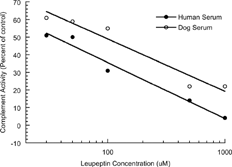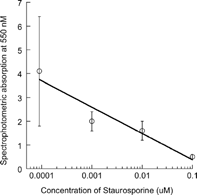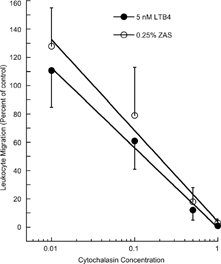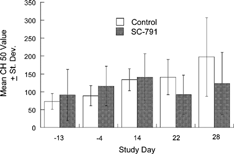Figures & data
TABLE 1 Comparative cyclooxygenase inhibiting properties of ibuprofen, naproxen, SC-236, SC-791, and SC-245
FIG. 1 Inhibitory effects of leupeptin on human and canine complement activities. Human and canine complement were incubated with opsonized sheep erythrocytes in the presence of leupeptin (30, 50, 100, 500, or 1000 μM) for 60 minutes. Each data point represents the mean of 6 to 9 experiments, each consisting of 3 replicate incubations. Optical density was measured at 540 nm. Data points represent absorbance expressed as percent of control (0 μ M leupeptin). Leupeptin IC50 concentrations were 38.2 and 106.8 μM for human and dog sera, respectively.

FIG. 2 Inhibitory effect of staurosporine on PMA (100 ng/mL) induced superoxide anion formation by canine neutrophils. Neutrophils were exposed to 100 ng/mL PMA in the presence of 0, 0.001, 0.01, or 0.1 μM of staurosporine and optical density at 550 nm was determined. Data points represent the mean ± SD of 4 incubations, each conducted in triplicate.

TABLE 2 Responsiveness of canine leukocytes to chemoattractantsFootnote1
FIG. 3 Inhibitory effects of cytochalasin B on chemotaxis of canine leukocytes toward LTB4 and ZAS. Canine leukocytes were exposed to 0.01, 0.1, 0.5, or 1.0 μM cytochalasin B then exposed to either 5 nM LTB4 or 0.25% ZAS. Leukocytes migrating through filters were counted. Extent of migration in the absence of cytochalasin was considered to be 100% of control and effects of cytochalasin were expressed as percent of control.

TABLE 3 Effects of leupeptin, naproxen, and selective cox-2 inhibitors on canine complement activity in vitro
FIG. 4 Functional hemolytic complement levels in female beagle dogs dosed for up to 28 days with SC-791.

TABLE 4 Effects of staurosporine, naproxen, and selective COX-2 inhibitors on PMA-induced superoxide anion production by canine neutrophils
TABLE 5 Oxidative burst assessed through hydrogen peroxide production in SC-791-exposed canine neutrophils challenged with PMAFootnote1
TABLE 6 In vitro effects (specific migration) of naproxen and selective COX-2 inhibitors on canine leukocyte chemotaxis
TABLE 7 Effects of selective COX-2 inhibitors on canine and human leukocyte transmigration through endothelial monolayers